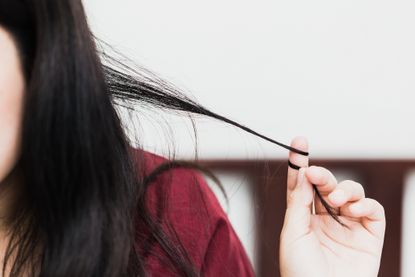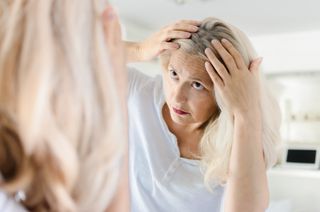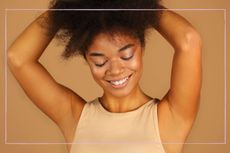Trichotillomania: Everything you need to know about the hair-pulling condition
Plus what you need to know about living with the condition...

Trichotillomania has recently hit headlines as former TOWIE star Sam Faiers revealed her worries about passing on the condition to her daughter Rosie.
The mum-of-three candidly revealed that she's suffered with the disorder - which is when someone can't resist the urge to pull out the hair on their head, eyebrows, eyelashes - since she was eight years old. Sam is now undergoing therapy for the disorder. But what is trichotillomania, and why does it happen?
Trichotillomania: what is it, and why does it happen?
It's thought that trichotillomania comes about as a way of dealing with stress or anxiety, and is one form of obsessive compulsive disorder (OCD). For others, it's considered a type of self-harm.
Harley Street hypnotherapist and Addiction Expert Adam Cox said: 'Trichotillomania is also known as hair pulling disorder and sometimes abbreviated to trich and is when someone can't resist the urge to pull out their hair.
'They may pull out the hair on their head or in other places, such as their eyebrows or eyelashes and sometimes even pubic hair. This is considered as an anxiety related issue as many people find it helps to deal with stress and anxiety as a coping mechanism similar to how some people may bite or chew finger nails or pick their cuticles.'
If someone is dealing with trichotillomania, it usually means that they have an irresistible urge to pull out hairs from all over the body, and will feel an increasing sense of tension until they do. Typically, the hair-pulling is eventually accompanied by a sense of relief.
GoodtoKnow Newsletter
Parenting advice, hot topics, best buys and family finance tips delivered straight to your inbox.

Adam said: 'For most people it comes about as an accidental behaviour when they feel stressed or anxious and then they may pull at a hair just as part of fidgeting.
'The feeling of satisfaction or release when the hair is plucked then creates a psychological pattern as it temporary distracts away from the source of anxiety. This behaviour may have been conscious to begin with but as with most habits can quickly can become unconscious where the individual does it without thinking about it.
'The consequence of this is that there can be patches of hair missing in certain areas such as lashes and brows or parts of hair on the head such as around the ears.'
How common is trichotillomania?
Trichotillomania sufferers often feel alone in their struggles, however the condition can affect up to four in 100 people and is more common in young girls than boys. If you live with trichotillomania, you aren't alone. Celebs like Justin Timberlake, Katy Perry and Charlize Theron also suffer with the issue.

The hair-pulling can easily be done without the patient really even thinking about it - as a sort of unconscious way of dealing with certain feelings. However, it can often turn into an addiction, something that people find hard to stop even if they know they should.
Read more: What is psoriasis? Everything you need to know about the skin condition
How to treat trichotillomania
Try hypnotherapy or CBT
The NHS recommends habit reversal training, a type cognitive behavioural therapy (CBT), as a common treatment for trichotillomania.
The treatment can involve keeping a diary of your hair pulling and figuring out the triggers. It also aims to help you swap hair pulling for another action when you feel the compulsion, like squeezing a stress ball or fidget spinner. Hypnotherapy can also be a helpful tool for trichotillomania sufferers. Adam Cox advocates CBT combined with hypnotherapy as an effective form of treatment.
'CBT is now the recommendation for those with trich,' he said. 'If this is used alongside clinical hypnotherapy the results can often be quicker. As a clinical hypnotherapist specialising in phobias and anxiety I’ve worked with a few people with this condition and have successfully treated them in a single session.'
Therapy sessions for trichotillomania are available from Trichotillomania Support.
Cover up your hands or head
The NHS suggests that covering your hands with gloves or plasters may provide a short-term solution to the problem. Likewise, covering your head in something tight like a hat might help with hair pulling.
Sam Faiers previously mentioned covering her hands during her younger years, revealing in her famous 2016 YouTube video that she wore mittens as a child to ease the condition.
Read more: Could a 'sleep divorce' improve your relationship?
'We tried everything,' she said. 'Mum would put mittens on my hands when I slept as I was picking my eyelashes out in my sleep. I tried that really disgusting stuff that you put on your hands to stop you biting your nails, so that it would sting.'
Talk to loved ones
Sam also advised that getting support from her family helped her cope with the condition.
'I found it really helped talking to the people closest to you. I had my mum and my sister and we would talk about it. Even my sister and I would make jokes and make light of the situation. Just embrace your insecurities, I did it . Don’t be scared to talk to someone, a family member or a friend, because it really does help.'
You can also find support by talking to others with trichotillomania via the Trichotillomania Support online forum.
And remember you're not alone.
Amy is Senior Digital Writer across Woman & Home, GoodTo and Woman, writing about everything from celebrity news to health, fashion and beauty features. When she isn't obsessing over the latest dress drop from Marks & Spencer, you'll most likely find Amy out running, or with a cup of tea in hand ready to dive into a gripping new Netflix series.
-
 Worried about your teen 'being smelly'? They can't help it, according to scientists, and help is on its way to ease the problem
Worried about your teen 'being smelly'? They can't help it, according to scientists, and help is on its way to ease the problemWe know that puberty can cause all sorts of smells to emanate from teens - now scientists have revealed exactly what you're smelling, and how evolution contributed.
By Lucy Wigley Published
-
 Parenting coach shares 4 'powerful' reframes to try next time it feels like your kid is pushing all your buttons (and #4 is a game changer)
Parenting coach shares 4 'powerful' reframes to try next time it feels like your kid is pushing all your buttons (and #4 is a game changer)A parenting coach has shared four ways parents can reframe their thoughts when their kid has big emotions. Giving them a try could offer big results in little time.
By Lucy Wigley Published